Mahogany Bookcase with Glazed Doors and Cabriole Legs
You must be a subscriber, and be logged in to view price and dealer details.
Subscribe Now to view actual auction price for this item
When you subscribe, you have the option of setting the currency in which to display prices to $Au, $US, $NZ or Stg.
- Astragal / Glazing Bars - An astragal, bead or glazing bar is the term used to describe the wooden strips that divide the glass in a cabinet into sections. However it can also refer to the narrow beading on a multi-door cabinet or bookcase that covers the gap between the doors, when they are closed. The astragal is usually attached to the inner stile of the left-hand door (or the right hand as you look at it).
- Mahogany - Mahogany is a dense, close grained red-coloured timber from the West Indies and Central America. It was first imported into Europe in the the early 18th century and its use continued through the 19th century. It was popular for furniture making because of its strength, the wide boards available, the distinctive grain on some boards, termed flame mahogany and the rich warm colour of the timber when it was polished.. The "flame" was produced where a limb grew out from the trunk of the tree, and this timber was usually sliced into veneers for feature panels on doors, backs and cornices.
Some terms used to describe mahogany relate to the country from which it originally came, such as "Cuban" mahogany, "Honduras" mahogany etc. However unless the wood has been tested the names assigned are more a selling feature, rather than a true indication of the timber's origin. - Regency Period - The Regency period in English furniture design refers to the period when King George III, was declared unfit to rule in 1811, and his son ruled as proxy as Prince Regent, until 1820, and then, after the death of his father as George IV until his death in 1830. The Regency period was preceded by the Georgian period (George I, George II, and George III: 1714 - 1811), and was followed by the William IV period, which only lasted until 1837 when William IV died as was succeeded by Queen Victoria.
- Cabriole Leg - The cabriole leg evolved from an elongated scroll, curving out at the knee which may or may not be carved, and forming a serpentine shape as it descends to the foot.
First introduced into English furniture in the late 17th century, cabriole legs were widely used during the Queen Anne and early Georgian periods, where they frequently terminated in a pad foot or ball and claw foot. The style has had many imitators since then. The cabriole leg was re-introduced in the mid-19th century, and is commonly associated with the balloon-back dining or drawing-room chairs made in walnut, mahogany or, in Australia, cedar. The Victorian cabriole leg, on the whole, was rather more slender than the earlier form, following the French style, which emphasized the delicacy and daintiness of the chairs they were designed to support. Cabriole legs are sometimes found on windsor chairs, especially those made during the 18th century.
This item has been included into following indexes:
Visually similar items

A small walnut bookcase, 19th century, the two glazed doors above two drawers raised above four cabriole legs, 123 cm high, 88 cm wide, and 24 cm deep

Early 20th century New Zealand Colonial kauri floor standing corner cupboard of wide proportions with shaped gallery top, adjustable shelving enclosed by two astragal glazed doors on tapering legs with spade feet

A modern Chinese rosewood upright display cabinet with two glazed doors above two panelled doors, three adjustable shelves, plain top and four short legs with shaped aprons between 91 cm x 35 cm x 183 cm

A large Louis XV style carved and gilded kingwood vitrine, 19th century, with bevelled glass panels, 260 cm high, 141 cm wide, 60 cm deep
